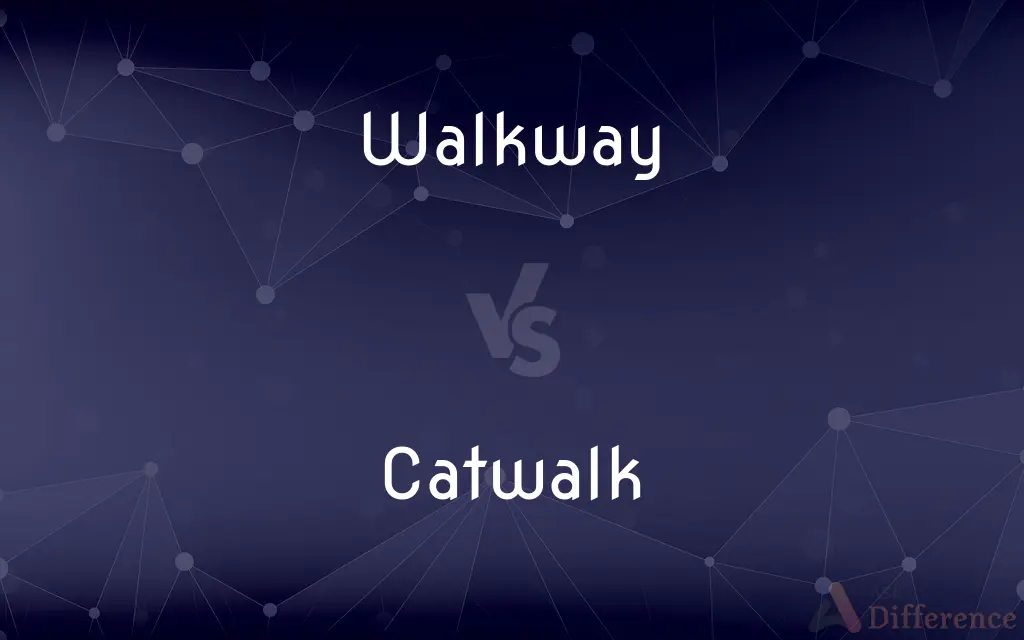Walkway vs. Catwalk — What's the Difference?
By Urooj Arif & Maham Liaqat — Updated on June 8, 2024
A walkway is a path for pedestrians, often outdoors, while a catwalk is a narrow, elevated platform used in fashion shows or for access in industrial settings.

Difference Between Walkway and Catwalk
Table of Contents
ADVERTISEMENT
Key Differences
A walkway is designed primarily for pedestrian use, providing a safe and designated path in various environments such as parks, gardens, or between buildings. On the other hand, a catwalk has a more specialized purpose. In the fashion industry, it refers to a narrow, usually elevated runway where models showcase clothing and accessories during a fashion show.
Walkways are versatile in their location and can be found both indoors and outdoors. They are designed to connect spaces, providing clear and accessible routes for individuals to walk from one point to another. Catwalks, particularly in fashion, are temporary structures that are often set up in various locations such as event halls, outdoors, or even historic locations to add allure to the fashion show.
The design of a walkway focuses on safety, accessibility, and sometimes aesthetics, ensuring that people of all abilities can use it comfortably. In contrast, the design of a catwalk, especially in fashion settings, focuses on visibility and the dramatic presentation of clothing.
Outdoor walkways might be landscaped to enhance their aesthetic appeal and integrate seamlessly with the surrounding environment. Industrial catwalks prioritize functionality, safety, and access, often equipped with safety rails and non-slip surfaces.
Comparison Chart
Purpose
For pedestrian use, connecting spaces
In fashion, for showcasing designs; industrially, for access
ADVERTISEMENT
Location
Indoors or outdoors
Indoors for fashion; various locations for industrial use
Construction
Ground level, various materials
Elevated, often metal for industrial, varied for fashion
Design Focus
Safety, accessibility, aesthetics
Visibility, presentation for fashion; safety, functionality for industrial
Typical Features
Handrails, lighting, benches
Safety rails, non-slip surfaces for industrial; dramatic lighting for fashion
Compare with Definitions
Walkway
A path designated for walking.
The garden's walkway was lined with roses.
Catwalk
A narrow runway for fashion shows.
The models strutted down the catwalk in the latest designs.
Walkway
An indoor corridor between rooms or buildings.
The museum's walkway featured historical exhibits.
Catwalk
A platform for showcasing clothing.
The designer's creations were a hit on the catwalk.
Walkway
A paved or marked footpath.
The walkway to the beach was crowded with tourists.
Catwalk
A temporary stage for fashion events.
The historic building was transformed with a catwalk for the evening.
Walkway
An outdoor passage for pedestrians.
The new walkway connects the park to the waterfront.
Catwalk
An elevated walkway in industrial settings.
The catwalk provided access to the top of the storage tanks.
Walkway
A trail designed for pedestrian use.
The scenic walkway offers breathtaking views of the mountains.
Catwalk
A narrow passage for access to hard-to-reach areas.
The catwalk allowed workers to reach the machinery safely.
Walkway
In American English, walkway is a composite or umbrella term for all engineered surfaces or structures which support the use of trails. The New Oxford American Dictionary also defines a walkway as "a passage or path for walking along, esp.
Catwalk
A platform extending into an auditorium, along which models walk to display clothes in fashion shows.
Walkway
A passage or path for walking along, especially a raised passageway connecting different sections of a building or a wide path in a park or garden.
Catwalk
A narrow walkway or open bridge, especially in an industrial installation.
Walkway
A passage or path for walking, especially one that is roofed, paved, or elevated above its surroundings.
Catwalk
A narrow, often elevated walkway, as on the sides of a bridge or in the flies above a theater stage.
Walkway
A clearly defined path for pedestrians.
Catwalk
(nautical) An elevated enclosed passage providing access fore and aft from the bridge of a merchant vessel.
Walkway
A path set aside for walking;
After the blizzard he shoveled the front walk
Catwalk
Any similar elevated walkway.
Catwalk
A narrow elevated stage on which models parade; a runway
Catwalk
The business of making clothes for fashion shows.
Catwalk
A narrow walkway projecting from a stage into the seating area of a theater; it is used, e. g. by models displaying clothes on it at a fashion show. Called also runway.
Catwalk
A narrow walkway high in the air to allow workers access to parts of a structure otherwise difficult to reach. Catwalks are located, e.g. above a stage in a theater, between parts of a building, along the side of a bridge, on the outside of a railroad car, on the outside of a large storage tank, etc.
Catwalk
Narrow platform;
Models displayed clothes on a catwalk at the fashion show
Catwalk
Narrow pathway high in the air (as above a stage or between parts of a building or along a bridge)
Common Curiosities
Can walkways be found indoors?
Yes, walkways can be both indoors and outdoors, connecting spaces for pedestrian use.
What materials are walkways made from?
Walkways can be made from concrete, asphalt, wood, stone, or other suitable materials for walking.
How is a catwalk different from a walkway?
A catwalk is a narrow, elevated platform used in fashion shows or for industrial access, while a walkway is a ground-level path for pedestrian use.
What safety features might a walkway include?
Walkways may include handrails, lighting, and non-slip surfaces for safety.
Are catwalks always elevated?
In most contexts, catwalks are elevated, especially in fashion shows and industrial settings for access purposes.
How do fashion shows utilize catwalks?
Fashion shows use catwalks as a platform for models to showcase clothing and accessories to the audience.
What is the primary focus when designing a catwalk for industrial use?
The primary focus is on functionality, safety, and providing access to maintenance workers.
What is a walkway used for?
A walkway is used to provide a safe and designated pedestrian path in various environments.
Do all catwalks in fashion shows have the same design?
No, the design of catwalks in fashion shows can vary greatly, often reflecting the theme of the show.
Can walkways serve as recreational paths?
Yes, walkways can also serve as recreational paths, such as in parks or scenic areas.
Why are catwalks used in industrial settings?
They provide safe access to machinery or parts of buildings that are hard to reach.
Are there regulations governing the construction of walkways?
Yes, there are often local regulations and standards to ensure the safety and accessibility of walkways.
Can the design of a walkway enhance its surroundings?
Yes, the design and landscaping of outdoor walkways can enhance the aesthetic appeal of their surroundings.
What is the significance of lighting in catwalk design?
In fashion shows, lighting enhances the visibility of the designs and creates a specific ambiance.
How do industrial catwalks ensure worker safety?
Industrial catwalks are equipped with safety rails, non-slip surfaces, and sometimes safety nets to prevent falls.
Share Your Discovery

Previous Comparison
Perinatal vs. Prenatal
Next Comparison
Pivot vs. SwivelAuthor Spotlight
Written by
Urooj ArifUrooj is a skilled content writer at Ask Difference, known for her exceptional ability to simplify complex topics into engaging and informative content. With a passion for research and a flair for clear, concise writing, she consistently delivers articles that resonate with our diverse audience.
Co-written by
Maham Liaqat















































